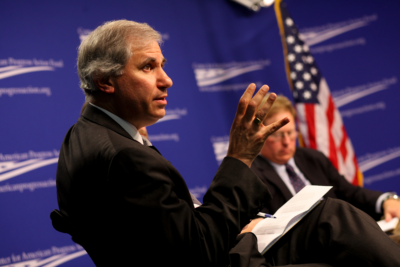Surviving the Roller-Coaster Ride that Is the U.S. Economy
The U.S. Economy is taking Americans for a ride, interest rates hit a 23-year high at 8.34 percent on 30-year mortgages.

Sign up to unveil the relationship between Wall Street and Washington.
It is absolutely reasonable right now to be flummoxed by the economy.
A brief assessment of the terrain: Interest rates on 30-year mortgages just clocked in at 8.34 percent, hitting a new 23-year high. That’s forcing many Americans to put off buying or selling a home, as the cost of becoming a first-time buyer, or simply rehoming oneself, is increasingly prohibitive. U.S. economic activity, most of the time described as highly “resilient,” has not been, really, with BlackRock dismissing strong jobs data and coming right out and saying 18-month growth has been the most laggardly on record outside a recession.
Finally, in recent days, U.S. Treasurys have been branded “the greatest bond bear market of all time” – as in, the most dismal in the nation’s 247-year history – according to data from Bank of America, which impressively pulled prices going back as far as 1811 (see chart, below).

And yet, the U.S. Federal Reserve is showing that households and nonprofits’ bond holdings have leapt as much as 80 percent from late 2021 to mid-2023, in response to rising returns on Treasury investments.
What gives? Since March 2022, the Fed has aggressively raised interest rates 11 times, from near-zero rates, to cool stubbornly high inflation.
That means new bonds issued at the higher rates offer better returns than the old bonds issued at lower rates, which offer more meager returns – hence bonds’ precipitous selloff, even as households scarf up newer bond holdings.
Amid this volatility, 30-year Treasury bond prices have plummeted more than 50 percent from peak to trough, with yields touching 5 percent last week for the first time since 2007.
Meanwhile, the rate on 10-year Treasury bonds, the bellwether for setting borrowing costs for mortgages and corporate debt across the nation, shot to nearly a two-decade high. (Don’t forget, earlier this year, these rapid interest rate changes also destabilized small- to mid-sized banks, as covered in detail by Power Corridor.)
“Surging long-term Treasury yields show markets are adjusting to a higher level tied to mega forces: looser U.S. fiscal policy, the big reallocation of resources in the low-carbon transition and geopolitical fragmentation rewiring supply chains,” BlackRock writes in its weekly market commentary.
The havoc wrought by these lightning-swift, post-pandemic shifts have caught many off guard, giving rise to such dire headlines as, “Higher Interest Rates Not Just for Longer, But Maybe Forever,” as seen recently in The Wall Street Journal, nodding to signals from the Fed that rates may stay higher for longer, maybe not forever, but at least for the foreseeable future.
This week, U.S. Treasury Secretary Janet Yellen sought to quell worries about the swooning $25 trillion U.S. bond market at the annual meetings of the International Monetary Fund and World Bank in Marrakesh, Morocco, telling The Financial Times, “I haven’t seen any evidence of dysfunction in connection with the increase in interest rates. When rates are more volatile, sometimes you see some impact on market function, but that is pretty standard.”
Whether the Fed is done with its campaign of rate hikes – or may even move to cut rates as soon as next year – remains a subject of hot debate.
More immediately, if the Fed keeps borrowing costs elevated, it won’t just apply to American consumers, it also will apply to the federal government, which will need to fork over ever-larger amounts of money to service its national debt – which now stands at more than $33 trillion.
That’s more than the total annual output of the U.S. economy – and will continue to be, until the U.S. gets its budget deficit under control.
In light of this, it is not hard to see why Congress continues fighting over spending, the nation’s deficit and government shutdowns.











